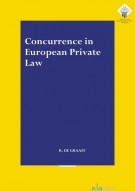Concurrence in European Private Law
- ISBN: 9789462361348
- Editorial: Eleven International Publishing
- Fecha de la edición: 2020
- Lugar de la edición: The Hague. Países Bajos
- Encuadernación: Rústica
- Medidas: 23 cm
- Nº Pág.: 225
- Idiomas: Inglés

In the multi-level legal order, it is not unusual for a legal relationship between private parties to be governed by multiple Union rules on, for instance, non-discrimination, free movement, competition and the internal market more broadly. Nor is it uncommon that, on the face of it, national private law creates rights and duties as well. In such situations of concurrence, the question that arises is whether the interested party may elect the rule of his choice. Is he entitled to choose the rule which appears to him to be the most advantageous?
This book offers a scheme of analysis by which this question can be debated and solved. Inspired by the experiences gained from examining several national systems of private law, the book starts from the premise that each rule, however founded, should be realised to the greatest possible extent. In principle, the existence of one rule does not, therefore, affect the scope of application of another rule. The book demonstrates that this principle also runs through the texts adopted by the Union legislature and through the judgments delivered by the Court of Justice of the European Union. It makes a clear case that in situations of concurrence, the substance of the rules should be decisive, and not merely their formal relationship
1 General Introduction 1
1.1 An old discourse and a new debate 1
1.2 Different visions of the structure of the legal system 4
1.3 This book’s focus on legal relations 9
1.4 Questions and outline 12
1.5 Scope and methodology 14
2 Concurrence in Private Law 19
2.1 Introduction 19
2.2 Concurrence of legal rules 20
2.3 Claims, powers, defences 22
2.4 General and specific rules: lex specialis derogat legi generali? 26
2.5 An alternative scheme of analysis 29
2.6 Conclusion 34
3 Concurrent Claims in Contract and Tort: A Comparative
Perspective* 37
3.1 Introduction 37
3.2 Concurrence of the laws of contract and tort 38
3.3 The differences between the laws of contract and tort 41
3.4 French law: the gradual emergence of the non-cumul principle 43
3.5 German and Dutch Law: independent yet interdependent categories 48
3.6 English Law: independent yet interdependent categories 54
3.7 Conclusion 58
4 Concurrence in European Private Law: Two Underlying Propositions 61
4.1 Introduction 61
4.2 The sources of Union law and their effects 62
4.3 Primary Union law: claims and defences 66
4.4 Secondary Union law: claims, powers, defences 72
4.5 How to solve questions of interpretation in a multi-level legal order? 79
4.6 Conclusion 82
5 Concurrence in Primary Union Law 85
5.1 Introduction 85
5.2 Article 18 TFEU and free movement law 87
5.2.1 Introduction 87
5.2.2 General and specific prohibitions of discrimination 89
5.2.3 From a discrimination approach to a restriction approach 92
5.2.4 Consequences for the interpretation of Article 18 TFEU? 96
5.2.5 Concurrence of Article 18 TFEU and free movement law? 101
5.2.6 Interim conclusion 105
5.3 Articles 101 and 102 TFEU 105
5.3.1 Introduction 105
5.3.2 A brief overview of the provisions 106
5.3.3 Similarities between Articles 101 and 102 TFEU 107
5.3.4 Differences between Articles 101 and 102 TFEU 110
5.3.5 Concurrence of Articles 101 and 102 TFEU? 114
5.3.6 Interim conclusion 117
5.4 Articles 101 and 102 TFEU and free movement law 118
5.4.1 Introduction 118
5.4.2 Similarities and differences between the provisions 118
5.4.3 Concurrence of competition law and free movement law? 123
5.4.4 Interim conclusion 127
5.5 Conclusion 128
6 Concurrence in Secondary Union Law 131
6.1 Introduction 131
6.2 When the Union legislature explicitly leaves room for other Union rules 132
6.3 When the Union legislature remains silent about the relationship between Union rules 137
6.4 How to determine whether national laws are affected by secondary Union rules? 143
6.5 The case of ‘complete’ harmonisation of national laws 147
6.6 The first exception: alternative rules 150
6.7 The second exception: exclusive rules 155
6.8 Conclusion 159
7 General Conclusion 161
7.1 Concurrence all over the place 161
7.2 Fundamental assumptions challenged 163
7.3 A shared scheme of analysis 165
7.4 Understanding the laws of the European Union 167
7.5 Lessons learned and questions raised 171
Table of Contents IX
Treaties and Legislation 177
International treaties 177
European Union law 177
Primary law 177
Secondary legislation 177
Directives 177
Regulations 181
Documents 184
National legislative texts and proposals 184
France 184
The United Kingdom 185
Case law 187
Union Courts 187
Judgments delivered by the Court of Justice of the European Union 187
Judgments delivered by the General Court of the European Union 194
Opinions of the Court of Justice of the European Union 194
Opinions of Advocates-General of the Court of Justice of the European Union 194
National Courts 195
France 195
Germany 195
The Netherlands 196
The United Kingdom 197
Literature 199






